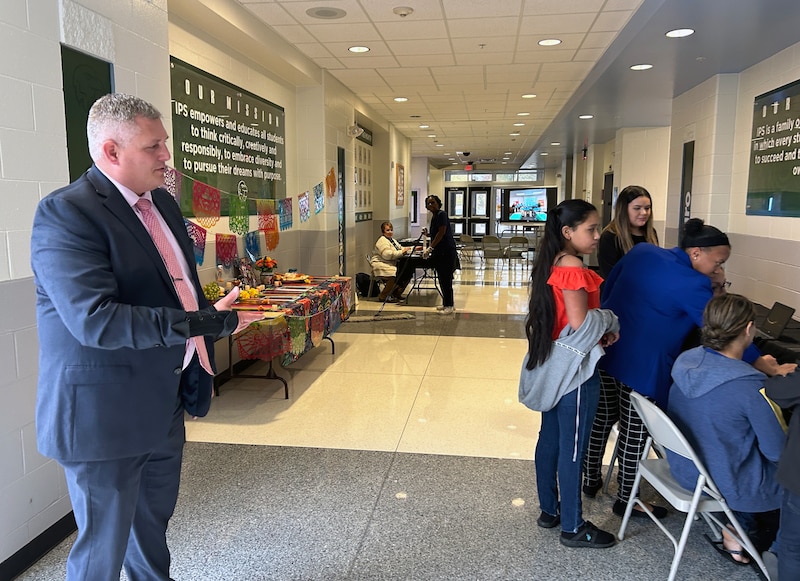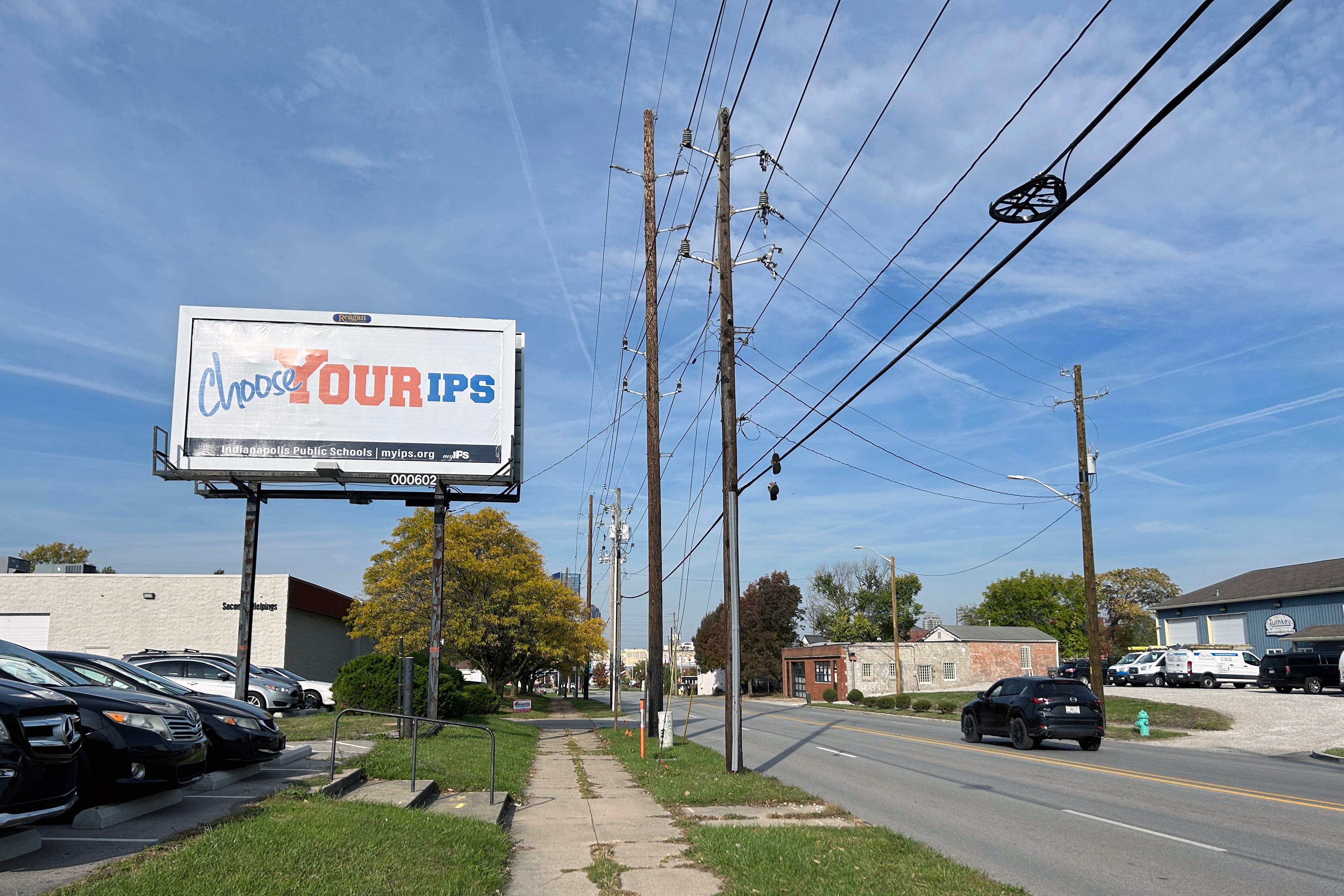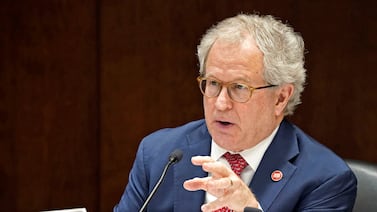Sign up for Chalkbeat Indiana’s free daily newsletter to keep up with Indianapolis Public Schools, Marion County’s township districts, and statewide education news.
Bridget McIntyre has no idea where she will send her daughter once she reaches sixth grade.
She has one school year to figure it out: Her daughter, now in fourth grade at Daniel Webster School 46, will stay there for fifth grade next year, when the school will shrink from pre-K-8 to pre-K-5.
A few years ago she wouldn’t be faced with this decision, and her daughter would have attended School 46 through eighth grade, just as her son did. Now, she has to do more research on her daughter’s middle school options.
“I know where I don’t want to send her to as far as out-of-district schools,” she said. “But I’m not for sure I’m keeping her in-district.”
The next few years will be critical for Indianapolis Public Schools as it rolls out its plan to break up K-8 schools and provide rigorous academic offerings to all students in a push for equity. But as the district faces declining student enrollment in its traditional schools, there’s another big task: convincing families facing a move to a new school to stay in the district.
During the enrollment period for the next school year that ends April 19, IPS will need to actively market to parents and families in an already hyper-competitive school choice environment in which IPS is regularly losing students in its non-charter schools.
The district, meanwhile, is working hard to ensure families know their options: opening elementary and middle schools to public tours, training principals on how to sell their school, and even offering school-day field trips for elementary students to visit the middle school where they are guaranteed a seat.
New and bigger enrollment zones will give parents the options to choose from multiple IPS schools — a setup that the district has marketed as an invitation for families to “Choose your IPS.”
Officials hope that the reorganization taking place in 2024-25 will ultimately boost enrollment by expanding specialized academic programming, and offering more rigorous academic courses and electives. By reconfiguring grades, all middle school students will have access to band or orchestra, a world language, and Algebra 1.
They also hope the bigger enrollment zones will allow more students to remain at their school if they move a short distance away.
“Our hope is that with those three things combined, our three- and five-year projections would be very positive and would reflect an upward trend because of how much more students are being offered,” said Patrick Herrel, the district’s director of enrollment and options.
But there’s no guarantee it will work, as private school options as well as charters grow in popularity.
“In a way you could argue they’re fighting fire with fire here,” Christopher Lubienski, director of the Center for Evaluation & Education Policy at Indiana University, said of the district’s marketing campaign. “It’s hard to outchoice the charters and the voucher schools, but that seems to be the battleground they’re choosing.”
Families that endured the pandemic face more upheaval
The stakes could hardly be higher for IPS. An analysis by Lubienski and others at the center found that the district has lost roughly 41% of its student population from 2006 to 2022, or more than 15,500 students. (That figure excludes students in charters that are part of the district’s Innovation Network.)
But even when families acknowledge what IPS is trying to do, some have other big concerns that marketing and expanded options don’t address.
It was a hard decision for Jill Davis to pull her two children out of Center for Inquiry School 70 in the middle of last school year and place them in a private school.
The family had already gone through the challenges of pandemic learning. The district’s Rebuilding Stronger plan, which would send her sixth grader to a new school when the school switches from pre-K-8 to pre-K-5, was the latest wave of instability. The plan would have required her children to leave the school for middle school — a change that, combined with other factors, led her and her husband to pull their children out of IPS.
“For our family, I just didn’t have the stomach to take now what’s probably going to be the hardest part of school, middle school, and have the school part be not constant,” she said.
Davis appreciates the district’s plan to make academics more equitable for all students, and knows she has the privilege of being able to choose to leave. But the plan, to her, seemed a lot to implement in a short amount of time.
“I kind of feel like everybody’s in a snow globe,” she said. “And they’re just going to shake it and see how things fall out.”
As IPS reconfigures, its highest flight risks may be families like Davis’ in magnet schools — specifically Montessori, CFI, Butler lab, and high-ability schools — where students are more likely to be white and not from low-income backgrounds, such as CFI 70. Parents from these schools voiced some of the strongest objections and concerns to the Rebuilding Stronger plan.
CFI 70, for example, was roughly 66% white last school year with about 25% of students qualifying for free or reduced-price lunch, according to state data. In IPS as a whole, white students in non-charter schools made up roughly 21% of the population, while 68% of students qualified for free or reduced-price lunch.
Other parents like what Rebuilding Stronger involves, regardless of the upheaval it will require.
Officials’ promise of stronger and more diverse academic offerings is what has parents like Brooke Thomas enthusiastic. Her son, who’s in the sixth grade at Butler Lab School 55, will attend Broad Ripple Middle School next year.
“I’m really excited for Cameron to be able to be in a middle school environment,” Thomas said. “I like the idea that he’ll have so many more offerings than a single K-8 building.”
IPS hopes changes will stabilize and grow enrollment
Parents like McIntyre do have logistical concerns about how the plan will roll out. She wonders, for example, how the closure of six schools earlier this year and the opening of others will affect staffing and transportation.
Behind the scenes, IPS is working on staffing projections and transportation routes, officials say.
“I can totally understand these parents’ concerns,” Herrel said. “This is exactly what we are working on right now with a lot of really detailed information that we already have.”
The district is also looking to the past to determine what kind of impact the reorganization will truly have on enrollment.
Student enrollment in non-charter IPS schools has been shrinking in small increments in recent years (although the district lost a more significant amount during the pandemic). But overall enrollment — which includes students in the district’s Innovation Network schools — has not decreased significantly when the district has closed schools or reconfigured grades in the past, Herrel said.
In fact, the district has seen slight increase in enrollment from students transferring into the district when it has expanded Butler lab or Center for Inquiry schools, he added. But he cautioned against making overly optimistic projections.
“Just because part of Rebuilding Stronger is launching new programs, we don’t want to overestimate in this first year how much of a magnet that will be” as far as attracting students to IPS, he said. “We hope it will be, and we anticipate over time it will be.”
Some leaders, families excited about district’s changes
At Brookside School 54, the Rebuilding Stronger plan is designed to bring stability.
The school, which serves a high percentage of families from low-income backgrounds, has struggled with student transiency throughout the school year as families move elsewhere in the city. The bigger enrollment zone means that fewer families will need to enroll in a new school just because they move a short distance away from Brookside.
“It’s going to be a game-changer,” said Principal Jeremy Baugh.

As an “exploratory” model school, Baugh markets the school as one that will prepare students for college and career while also allowing students to explore the community and neighborhood around Brookside. It offers everything from small-group math instruction to a pottery studio.
But with Rebuilding Stronger, next year the school will at least double the number of enrichment opportunities for students by adding things like a makerspace, Baugh said.
Baugh is not flustered by the competition he could face from other IPS schools. With about 430 pre-K-6 students this year, the goal is to reach an enrollment of about 500 next school year, even after the school drops the sixth grade next year.
And many new families are excited about coming to Brookside, now that they fall into the school’s enrollment zone, Baugh said.
“Is it an option to potentially lose children? It always is, and I think it always has been,” he said. “I think our goal is to make sure that whatever we offer in our school, it’s great for families.”
Like Baugh, Thomas is excited for the district’s changes next year and thinks they’re well thought out.
“I’m excited to see it play out and get implemented,” she said. “It probably won’t end up exactly right like they had thought. They’ll just adjust as they go. But it really seems like the best possible path to put IPS on.”
Amelia Pak-Harvey covers Indianapolis and Lawrence Township schools for Chalkbeat Indiana. Contact Amelia at apak-harvey@chalkbeat.org.





